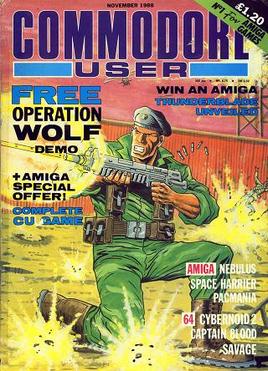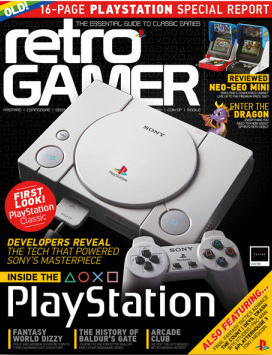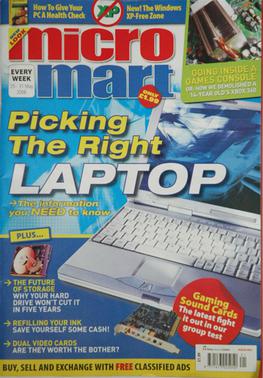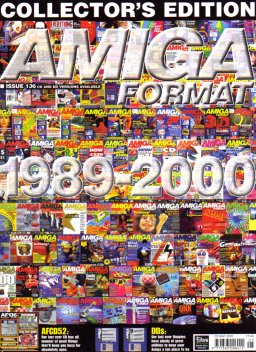
Amiga is a family of personal computers introduced by Commodore in 1985. The original model is one of a number of mid-1980s computers with 16- or 16/32-bit processors, 256 KB or more of RAM, mouse-based GUIs, and significantly improved graphics and audio compared to previous 8-bit systems. These systems include the Atari ST—released earlier the same year—as well as the Macintosh and Acorn Archimedes. Based on the Motorola 68000 microprocessor, the Amiga differs from its contemporaries through the inclusion of custom hardware to accelerate graphics and sound, including sprites and a blitter, and a pre-emptive multitasking operating system called AmigaOS.

The Atari Lynx is a 16-bit fourth-generation hand-held game console released by Atari Corporation in September 1989 in North America and 1990 in Europe and Japan. It was the first handheld game console with a color liquid-crystal display. Powered by a 4 MHz 65C02 8-bit CPU and a custom 16-bit blitter, the Lynx was more advanced than Nintendo's monochrome Game Boy, released two months earlier. It also competed with Sega's Game Gear and NEC's TurboExpress, released the following year.
The Konix Multisystem was a cancelled video game system under development by Konix, a British manufacturer of computer peripherals.

Commodore User, later renamed to CU Amiga, is a series of American and British magazines published by Commodore International.

Retrocomputing is the current use of older computer hardware and software. Retrocomputing is usually classed as a hobby and recreation rather than a practical application of technology; enthusiasts often collect rare and valuable hardware and software for sentimental reasons.

Sensible Soccer, often called Sensi, is an association football video game series which was popular in the early 1990s and which still retains a following. It was developed by Sensible Software and first released for Amiga and Atari ST computers in 1992 as well as for the IBM PC compatibles. The series was created by Jon Hare and Chris Yates, as a successor to their previous football game MicroProse Soccer (1988), which in turn was inspired by the arcade video game Tehkan World Cup (1985).

The One was a video game magazine in the United Kingdom which covered 16-bit home gaming during the late 1980s and early 1990s. It was first published by EMAP in October 1988 and initially covered computer games aimed at the Atari ST, Amiga, and IBM PC compatible markets.

Zero was a video game magazine in the UK, published monthly by Dennis Publishing Ltd. between November 1989 and October 1992. It won the InDin Magazine of the Year award in both 1990 and 1991, and was also briefly the best-selling multi-format 16-bit computer magazine in the UK.
Artworx was a Naples, Florida software company that produced and supported a line of computer games from 1981 to 2015. It is named after the founder's given name. At first the company published a variety of games, including titles in adventure and arcade-action genres, but were later best known for a strip poker series.

Retro Gamer is a British magazine, published worldwide, covering retro video games. It was the first commercial magazine to be devoted entirely to the subject. Launched in January 2004 as a quarterly publication, Retro Gamer soon became a monthly. In 2005, a general decline in gaming and computer magazine readership led to the closure of its publishers, Live Publishing, and the rights to the magazine were later purchased by Imagine Publishing. It was taken over by Future plc on 21 October 2016, following Future's acquisition of Imagine Publishing.

Mastertronic was originally a publisher and distributor of low-cost computer game software founded in 1983. Their first games were launched on April 2, 1984. At its peak the label was one of the largest software publishers in the UK, achieved by selling cassette-based software at £1.99. As well as supplying leading retailers such as Woolworth's and Toys "R" Us, Mastertronic sold software in outlets such as newsagents which had not been previously associated with the software market.

Robert J. Mical is an American computer programmer and hardware designer who has primarily worked in video games. He is best known for creating the user interface, Intuition, for Commodore's Amiga personal computer (1985), contributing to the design of the Amiga hardware, and co-designing, with Dave Needle, the Atari Lynx color handheld (1989) and the 3DO Interactive Multiplayer (1993).

Micro Mart was a weekly computer magazine published in the United Kingdom by Dennis Publishing Ltd. As of 2015, it had a circulation of 5,422. In a letter to subscribers in December 2016 it was announced that the magazine would cease publication with issue No 1445 : "After 30 amazing years of telling it like it is, Micro Mart magazine is logging off."

Amiga Format was a British computer magazine for Amiga computers, published by Future plc. The magazine lasted 136 issues from 1989 to 2000. The magazine was formed when, in the wake of selling ACE to EMAP, Future split the dual-format title ST/Amiga Format into two separate publications. In 1991, the magazine was selling 135,000 copies a month.

Centurion: Defender of Rome is a turn-based strategy video game with real-time battle sequences, designed by Kellyn Beck and Bits of Magic and published by Electronic Arts. Originally released for MS-DOS in 1990, the game was later ported to the Amiga and the Sega Genesis in 1991. Centurion shares much of the concept and feel with Beck's earlier game Defender of the Crown (1987).

Alien Breed 3D II: The Killing Grounds is a first-person shooter game developed by Team17 for Amiga. Published by Ocean Software in 1996, it is the fifth game in the Alien Breed franchise, a series of science fiction-themed shooters.

Black Gold is a business simulation game released in 1989 by reLINE Software.
Igromania is a Russian video game website and formerly a magazine.

Elvira II: The Jaws of Cerberus is the second game in the Elvira series of horror adventure/role-playing video games. It was developed by Horror Soft and published by Accolade in 1992. The game is a sequel to 1990's Elvira: Mistress of the Dark. It was followed by Waxworks, which can be considered its spiritual sequel.

Battle Chess II: Chinese Chess is a 1990 video game published by Interplay Productions. It is a xiangqi game in which the pieces on a green field split down the center by a river, are placed at the intersecting points where the field is divided vertically by nine lines and horizontally by ten.

















